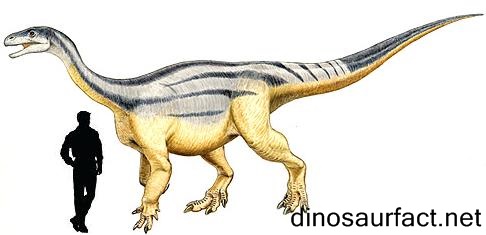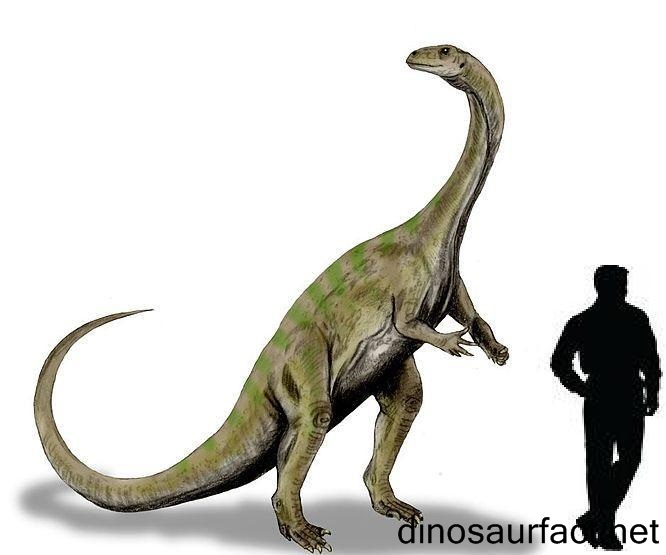 Click to visit the previous dinosaur bio
Click to visit the previous dinosaur bio
 |
|
 |
|
Kingdom: Animalia
Phylum: Chordata
Class: Sauropsida
Superorder: Dinosauria
Order: Saurischia
Suborder: Sauropodomorpha
Family: Melanorosauridae
Genus: Melanorosaurus
 |
|
 |
|
 |
|

The Melanosaurus dinosaur is a dinosaur that lived between 227 and 208 million years ago. Belonging to the Norian and Rhaetian stages of what is known as the Late Triassic or Upper Triassic period, it lived in the jungles of the present-day country of South Africa. It was a typical quadrapedal dinosaur that feasted on leaves and shrubs.
The Triassic Period
The Triassic period is the first or lowermost period of the Mesozoic era. The Permian age precedes the Triassic while the Jurassic follows it. The final epoch of the Triassic period, the Upper Triassic or Late Triassic is the source of many early dinosaurs, including theropods and sauropodomorphs. This period is divided into three ages or stages. Of these, the Carnian is the first or lowermost age, followed by the intermediate or middle Norian and the last stage or age is the Rhaetian.
The Upper Triassic covers the entire timeframe from approximately 235 to 201 million years ago. It is preceded by the Middle Triassic and marks the end of the Triassic period, being followed by the better known Jurassic period.
The discovery of fossils
The Melanosaurus fossils were discovered in Transkei, South Africa. The creature derives its name (which translates to ‘Black mountain Lizard’) from the Thaba ‘Nyama or “Black Mountain”, on whose slopes the first fossils were found. The first fossils are classified as the SAM 3449 and SAM 3450. The fossils belong to the Lower Elliot formation.
It was paleontologist Sydney Henry Haughton, who first described these dinosaurs in 1924. The type species is M. readi. Another species Melanosaurus thebanensis also has been described based on remains found in an Upper Elliot formation. The holotype specimen for this species is the MNHN LES-16.
Sydney H. Haughton, born 7th May 1888 was the discoverer of these fossils. He was a South African paleontologist and geologist, a pioneer of sorts in the South African paleontological world. The Melanosaurus is what may be considered to be his masterpiece. He was also an honorary member of the Royal Society.
The Elliot Formation
The Elliot formation from South Africa is an ancient geological landscape. It is divided into two halves: namely the Upper Elliot Formation and the lower Elliot formation. The Upper Elliot consists of the Jurassic stages from the Ladinian to Sinemurian while the Lower Elliot Formation consists of rocks belonging to the Norian through Rhaetian stages of the Upper Triassic Period. It spans the time from 210 to 190 million years ago. The formation is rich with fossils of sauropods, ornithischians and theropods.
The physical features of the Melanosaurus dinosaur
The Melanosaurus was a comparatively large dinosaur. It is probably amongst the largest terrestrial creatures that are known, even if only through fossil data. Like all other sauropods of that time, the Melanosaurus had a long neck (although it was short in comparison to other known sauropods). The tail was long too, and it tapered towards the end and was flexible. It allowed for maintaining good balance.
The femur was straight and thick. The somewhat triangular skull was about 9 inches long and was full of openings to reduce overall skull weight. The hip bone was lizard like i.e. to say that the Melanosaurus was a saurischian dinosaur. The jawbone was fused with 38 teeth, 19 on each side. It had a tapering, pointed nose, which resembled a bird’s beak.
Being a quadrapedal dinosaur, the limbs were strong so they could support the entire body weight. It had the characteristic stout limbs that is often associated with large sauropods. The dinosaur is believed to have been somewhere between 30 to 40 feet long and stood about 12 feet tall at the hip and weighed about 200 tons.
About the Melanosaurus dinosaur
The Melanosaurus dinosaur was an ancient and early sauropod. It belonged to the Saurischian family of dinosaurs. An herbivorous creature, the dinosaur would eat the leaves of tall trees and other vegetation. Like other sauropods, these dinosaurs used to move in herds. Whether this was for protection or for whether the dinosaur was a social creature is debatable.
The Melanosaurus had a slow gait. It was a creature that could function both in the day and night and thus avoided the sweltering afternoon heats by resting beneath tall conifers. These creatures might have created the first civilization of sorts, despite their low intelligence.
The Melanosaurus dinosaur was earlier placed in the prosauropodomorpha, before being assigned as a sauropod. The closest relative to this dinosaur is its South American counterpart, the Riojasaurus from Argentina. Both of these creatures are huge herbivores, although more information is available about the Riojasaurus than the Melanosaurus. Another dinosaur that can be compared to the Melanosaurus is the Supersaurus, whose height and length can outmatch the Melanosaurus’ in its enormity.
Being one of the largest dinosaurs or even the largest terrestrial creature of its time, the Melanosaurus is an interesting species. The clumsy creature is even supposed to have lived through the Triassic Jurassic extinction event. It is one of the few creatures that have lived in both the Triassic and Jurassic stages. It is the key to understanding, how dinosaurs, despite their weight survived such calamity despite being herbivorous whereas several carnivores were doomed.
Even though not much is known about the Melanosaurus dinosaur, the dinosaur has still sparked an interest in early theropods. This is majorly due to the fact that these animals were so ginormous. They represent the general idea of dinosaurs being huge, monstrous creatures, although this creature could not have been a hostile one.
Even so, the need to further study this dinosaur still exists. How the dinosaur was able to survive despite its large size and vegetarian diet? How it avoided being the predator’s prey, what were its defense mechanisms? These and many more similar questions can be answered through more analysis of better fossil data. We should find these remains quickly, lest the fossils become extinct too under nature’s course, just like the animals they belonged to.
Index
Extinct Profiles
 Triassic Dinosaurs
Triassic Dinosaurs Jurassic Dinosaurs
Jurassic Dinosaurs Cretaceous Dinosaurs
Cretaceous Dinosaurs Pterosaurs
Pterosaurs Marine Reptiles
Marine Reptiles Dinosaur Extinction
Dinosaur Extinction